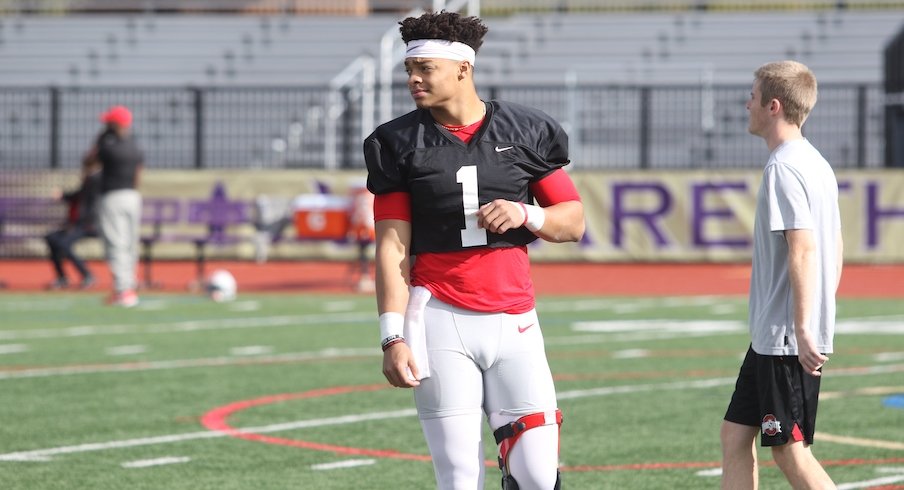SCOTTSDALE, Ariz. – When Justin Fields escapes the pocket on third downs, whether due to his own volition or pass protection breaking down, he feels no discomfort. No anxiety.
Because of an arm that has allowed him to pull off a 40-to-1 touchdown-to-interception ratio and speed that has him running 4.4-second 40-yard dash, he both keeps his eyes downfield but retains an ability to take off and attempt to move the chains with his legs. To any defense, even Clemson’s, that’s so, so difficult to defend. As Kevin Wilson noted on Tuesday, his legs have played a significant role in Ohio State’s nation-best 57 percent third-down conversion rate.
Just ask James Skalski, one of the linebackers charged with slowing him down in Saturday’s Fiesta Bowl with a spot in the national championship on the line.
“It's third-and-long and you're trying to spread out the zone coverage, match some routes and the next thing you know, this monster's full speed hauling ass in front of you,” Skalski said. “It's a game changer.”
When describing that aspect of Fields’ game, Clemson defensive coordinator Brent Venables turned to one of the NFL’s best teams to find a comparison, calling Fields “Lamar Jackson-like” in his ability to pick up yards after plays break down.
“It's frustrating. It's really hard,” he said. “You look at a guy like Lamar Jackson, Tom Brady does it different. He does it different than Lamar Jackson. Going into this game, I'd rather play a guy that's just one-dimensional because it's hard, it's really hard if they can run it and throw it equally as well and then when you have one covered, they can attack you with the other. It makes it hard.”
Fields won’t be a one-dimensional quarterback on Saturday. A still-hurting left knee could limit him somewhat, though.
On Tuesday, Fields volunteered to reporters that his left knee is only 80-85 percent healthy, saying he expected it to be healthier and noting that he might not be as patient as he would like. He had initially sprained his MCL against Penn State on Nov. 23 before reaggravating it a week later in the win versus Michigan and playing in the Big Ten title game the following week.
“My knee’s probably not like I wanted it to be right now, but I think with treatment every day and just resting it every day, hopefully it'll be better by the game,” Fields said on Tuesday. “And I'm probably going to wear the same (smaller) knee brace I started out with the Team Up North game.”
The two days following his comments, Fields practiced in the bulkier knee brace, likely for precautionary reasons before playing with the smaller brace on Saturday.
He’ll play on Saturday; that’s not a question. At this point, the remaining uncertainty centers around how Ohio State will use him if he’s limited at all. In the Big Ten title game, Fields’ mobility appeared somewhat affected by his knee, playing a role in him getting sacked five times and the Buckeyes converting 6-of-14 third downs, a lower percentage than usual.
“Luckily he's kind of healthy and rolling right now so we can kind of be a little more free with it, but I think coach (Ryan) Day's always very cautious of why and when and getting Justin to understand how to run and protect himself,” Wilson said on Tuesday.
That caution could lead to a sizable role for J.K. Dobbins.
In each of the past three games, he has tallied more than 30 carries, and it’s quite possible that his streak extends to a fourth game on Saturday. The Tigers have a defense ranked No. 1 in points allowed per game and No. 2 in yards allowed per play, but they trot out a younger-than-usual defensive line that Ohio State’s mauling offensive line might be able to take advantage of on Saturday. The unit’s run blocking made it a finalist for the Joe Moore Award, which honors the nation’s best offensive line, and it’ll get a chance to power the offense against Clemson.
The Buckeyes hope those runs will open up the air for Fields to thrive. In the moments when the quarterback drops back, he’ll have to make certain decisions of when he can take off and run or when he should play it safe. A hurting knee, he says, would affect his effectiveness situationally.
“You just have to know when to make a play and know when to be smart and kind of know what the situation is in the game,” Fields said. “So of course if it's the last few seconds of the game and we need a first down or something like that, then you can't really worry about the knee. But if it's first quarter, first and 10 and you're trying to make a play, just throw the ball away and be smart about it. I think it just comes with different situations.”
Wilson offered a similar explanation.
“You're maybe not as reckless, meaning it's bang for the buck,” Wilson said. “So if it's maybe the first play of the drive in the second quarter and you're 80 yards away, I don't know if it's a designed quarterback run. But in this day and age, he can always take off scrambling. So it's not like he's never not going to run.”
He might just not be Lamar Jackson. And as Ohio State showed against Michigan and Wisconsin, it can still win with a version of Fields that isn’t 100 percent healthy.
On Saturday, he'll have to proved he can beat a team as talented as Clemson without a fully healthy knee.


